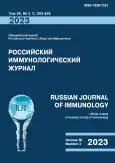Flow cytometry analysis of PD1 expression on rat blood CD3+ lymphocytes stimulated by CD3 antibodies
- Authors: Khramova T.V.1,2, Beduleva L.V.1,2, Fomina K.V.1,2, Abisheva N.N.1,2
-
Affiliations:
- Udmurt State University
- Udmurt Federal Research Center, Ural Branch, Russian Academy of Sciences
- Issue: Vol 26, No 3 (2023)
- Pages: 415-420
- Section: SHORT COMMUNICATIONS
- URL: https://journals.rcsi.science/1028-7221/article/view/253421
- DOI: https://doi.org/10.46235/1028-7221-9639-FCA
- ID: 253421
Cite item
Full Text
Abstract
The role of the PD-1/PD-L signaling pathway in the regulation of the immune response is currently the focus of research. Numerous studies have shown the key role of PD-1 molecules in the regulation of autoimmune, antitumor and antiviral reactions. The culture of rat and mice lymphocytes, as well as animal experimental models of immunopathologies are widely used in research. However, rat lymphocytes are almost not used to study the PD-1/PD-L pathway. There is no data on PD-1 expression or methods of its induction on rat lymphocytes. In human T-lymphocyte culture, PD-1 expression can be induced by NIB1412 anti-CD3 antibodies coated in the well of culture plates. In this study, we investigated the effect of G4.18 anti-CD3 antibody on PD-1 expression in peripheral blood lymphocyte of intact Wistar rats in vitro. According to some literature data, G4.18 anti-CD3 antibodies in immobilized form can activate isolated rat T cells, and according to others, inhibit allogeneic reactions in mixed lymphocyte culture and block cytotoxicity of cells obtained from rats with a developed graft rejection reaction. We found that incubation of rat blood lymphocytes with G4.18 anti-CD3 antibodies immobilized on plastic leads to a change in cell morphology and induction of PD-1 on CD3+ lymphocytes. After incubation with anti-CD3 antibodies, the proportion of PD-1+ lymphocytes among CD3+ lymphocytes was 12.05±6.04%, which is significantly higher than the proportion of such cells before incubation and during incubation in a cultural medium, which amounted to 2.60±2.62% and 4.59±5.81%, respectively. In the dot-plot graphs showing the distribution of cells according to the parameters of forward scatter and side scatter, PD-1+CD3+ lymphocytes induced by anti-CD3 antibodies are localized in the region of relatively lower forward scatter and greater side scatter. Perhaps these cells belong to apoptotic cells.
Keywords
Full Text
##article.viewOnOriginalSite##About the authors
Tatyana V. Khramova
Udmurt State University; Udmurt Federal Research Center, Ural Branch, Russian Academy of Sciences
Author for correspondence.
Email: khratat@mail.ru
PhD (Biology), Senior Research Associate, Laboratory of Molecular and Cell Immunology, Research Associate, Laboratory of Biocompatible Materials
Russian Federation, 1 Universitetskaya St., Izhevsk, Udmurtia, 426034; 34, st. them. Tatyana Baramzina, Izhevsk, 426067Liubov V. Beduleva
Udmurt State University; Udmurt Federal Research Center, Ural Branch, Russian Academy of Sciences
Email: lvbeduleva@gmail.com
PhD, MD (Biology), Associate Professor, Chief Research Associate, Laboratory of Molecular and Cell Immunology, Leading Research Associate, Laboratory of Biocompatible Materials
Russian Federation, 1 Universitetskaya St., Izhevsk, Udmurtia, 426034; 34, st. them. Tatyana Baramzina, Izhevsk, 426067Kseniya V. Fomina
Udmurt State University; Udmurt Federal Research Center, Ural Branch, Russian Academy of Sciences
Email: fomiksa@yandex.ru
PhD (Biology), Senior Researcher, Laboratory of Molecular and Cell Immunology, Senior Researcher, Laboratory of Biocompatible Materials
Russian Federation, 1 Universitetskaya St., Izhevsk, Udmurtia, 426034; 34, st. them. Tatyana Baramzina, Izhevsk, 426067Nadezhda N. Abisheva
Udmurt State University; Udmurt Federal Research Center, Ural Branch, Russian Academy of Sciences
Email: naidik84@mail.ru
PhD (Biology), Senior Researcher, Laboratory of Molecular and Cell Immunology, Researcher, Laboratory of Biocompatible Materials
Russian Federation, 1 Universitetskaya St., Izhevsk, Udmurtia, 426034; 34, st. them. Tatyana Baramzina, Izhevsk, 426067References
- Chikuma S. Basics of PD-1 in self-tolerance, infection, and cancer immunity. Int. J. Clin. Oncol., 2016, Vol. 21, no. 3, pp. 448-455.
- Francisco L.M., Sage P.T., Sharpe A.H. The PD-1 pathway in tolerance and autoimmunity. Immunol. Rev., 2010, Vol. 236, pp. 219-242.
- Nicolls M.R., Aversa G.G., Pearce N.W., Spinelli A., Berger M.F., Gurley K.E., Hall B.M. Induction of long-term specific tolerance to allografts in rats by therapy with an anti-CD3-like monoclonal antibody. Transplantation, 1993, Vol. 55, no. 3, pp. 459-468.
- Pauken K.E., Torchia J.A., Chaudhri A., Sharpe A.H., Freeman G.J. Emerging concepts in PD-1 checkpoint biology. Semin. Immunol., 2021, Vol. 52, 101480. doi: 10.1016/j.smim.2021.101480.
- Riella L.V., Paterson A.M., Sharpe A.H., Chandraker A. Role of the PD-1 pathway in the immune response. Am. J. Transplant., 2012, Vol. 12, no. 10, pp. 2575-2587.
- Sharpe A.H., Pauken K.E. The diverse functions of the PD1 inhibitory pathway. Nat. Rev. Immunol., 2018, Vol. 18, no. 3, pp. 153-167.
- Thaventhiran T., Alhumeed N., Yeang H.X., Sethu S., Downey J.S., Alghanem A.F., Olayanju A., Smith E.L., Cross M.J., Webb S.D., Williams D.P., Bristow A., Ball C., Stebbings R., Sathish J.G. Failure to upregulate cell surface PD-1 is associated with dysregulated stimulation of T cells by TGN1412-like CD28 superagonist. MAbs, 2014, Vol. 6, no. 5, pp. 1290-1299.
- Tran G.T., Carter N., He X.Y., Spicer TS., Plain K.M., Nicolls M., Hall B.M., Hodgkinson S.J. Reversal of experimental allergic encephalomyelitis with non-mitogenic, non-depleting anti-CD3 mAb therapy with a preferential effect on T(h)1 cells that is augmented by IL-4. Int. Immunol., 2001, Vol. 13, no. 9, pp. 1109-1120.
Supplementary files








